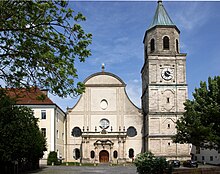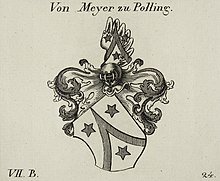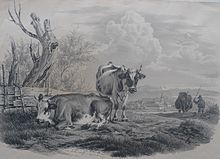Polling Monastery

The Polling Abbey is a former monastery of the Benedictine , the Augustinian Canons in Polling in Upper Bavaria Weilheim-Schongau .
history
Middle Ages and early modern times
According to legend, Duke Tassilo III founded. from Bavaria around 750 in Polling a Benedictine monastery. The real founders were probably members of the Huosi , a local noble family. The monastery suffered expropriations under Arnulf of Bavaria and was damaged in the Hungarian Wars . From 1010 regular canons lived in Polling again, who had lived according to the rules of Augustine since the beginning of the 12th century . A new church was built and consecrated in 1160 by the Bishop of Brixen , to the monastery and provost of Polling ("monasterium et prepositura in villa Pollingen in pago Hǒsen") in 1065 by King Henry IV . In the second half of the 12th century canons are also mentioned for the first time, which adopted the Benedictine rule around 1300 and moved to Benediktbeuern . In the 13th century, Polling became the destination of pilgrimages to the “To the Cross”. The church burned down at the beginning of the 15th century and was rebuilt in 1416–1420 in Gothic style. Provost Johannes Zinngießer had the prefecture, the refectory and the library built from 1499 to 1523, and the church was redesigned in the late Gothic style. The Madonna carved by Hans Leinberger was created around 1526 . Johannes Eck is said to have been in Polling several times at this time.
Baroque and Enlightenment
In 1714 the construction of the monastery began. From 1721 the monastery school was expanded. From then on, the Jesuit curriculum was used there . Polling Monastery played a key role in financing the Wieskirche, which was built by Steingaden Monastery in the years 1745–1754 . One of the teachers at the monastery school was Eusebius Amort (1692–1775). He published the journal Parnassus Boicus with articles on physics, chemistry, astronomy, meteorology, history and grammar and was later one of the founders of the Bavarian Academy of Sciences . One of his students was Franz Töpsl , who during his time as provost (1744–1796) had the library expanded and the church redesigned. He took care of scientific cabinets and had an observatory built. To encourage his confreres to be scientifically active, Töpsl had portraits of learned Augustinian canons made and hung in the corridors of the monastery. The remains of this canon gallery ( Pollinger Pinakothek ), which once comprised more than 200 portraits, are now in the possession of the archive of the Ludwig Maximilians University in Munich . In 1803 the monastery was secularized . The monastery library at that time comprised 88,000 volumes, of which around 20,000 went to the court library in Munich and 7,000 to the Ingolstadt university library . The rest was wasted .
Owned by Swiss agricultural pioneers
In 1804, the Swiss silk ribbon manufacturer, patron, philanthropist and revolutionary Johann Rudolf Meyer (1739–1813) from Aarau acquired the Polling monastery. 1805–1807 it was administered by his son Johann Rudolf (1768–1825), who dedicated an encyclopedia of chemistry to King Max Joseph . In 1812 it was given to his brother Jerome called Jérôme (1769–1844). Johann Rudolf and he had succeeded in the first ascent of a four-thousand-meter peak in Switzerland - the Jungfrau - the year before . In 1814 Hieronymus Meyer was raised to hereditary nobility for services to Bavarian agriculture. In 1817 he sold the estate to a compatriot, the nephew of his stepmother, Major Samuel Abraham von Renner (1776–1850). Although distinguished as a model farmer, he had to cede it to a believer in 1843. It is controversial whether monastery buildings were demolished in the four decades in which the estate was in Swiss possession.
Row of provosts
source
- Aribo
- Herrich
- Arnold, around 1073
- Hiltipert
- Chuno, 1136
- Conrad I., 1177, † 1180
- Berthold, 1186, 1195, † 1212
- Eglo, † 1224
- Manegold, 1224-1226
- Heinrich I, † 1247
- Dietrich, † 1254
- Gunther, 1263, † 1272
- Hermann, 1273
- Heinrich II., † 1279
- Conrad II. Ainsinger, 1279-1313
- Henry III. Ebersperger, 1313-1334
- Conrad III, 1334-1336
- Ulrich I., 1336-1341
- Henry IV, 1341-1345
- Conrad IV. Schondorfer, 1345-1387
- Ulrich II. Kalkmair, 1387–1404
- Wilhelm Daberzhofer, 1404-1433
- Ulrich III. Schütz, 1433-1450
- Johann I. Mairhofer, 1450-1454
- Johann II. Vent, 1454-1491
- Michael Spät, 1491-1499
- Johann III. Zingießer, 1499-1523
- John IV Vent, 1523-1530
- Johann V. Hartl, 1530-1531
- Gregor Pez, 1531-1562
- Erhard Eyerl, 1562–1571
- Jacob Schwarz, 1571–1591
- Caspar Leis, 1591-1616
- Kilian Westerrieder, 1616–1633
- Hartmann Koch, 1633-1634
- Sigmund Pschorn, 1634-1643
- Anther Azwanger, 1643-1669
- Claudius Plank, 1669-1682
- Valerius Baudrexl, 1682-1701; received the pontificals in 1689
- Albert Oswald, 1701-1744
- Franz Töpsl , 1744–1796
- Johann VI. Nepomuk Daisenberger, 1796–1803, † 1820
Todays use
The important late Gothic monastery church Heilig Kreuz with early baroque stucco by the Wessobrunner Georg Schmuzer became a parish church in 1803. Some of the monastery buildings came into the possession of Dominican women from St. Ursula in Donauwörth in 1892 , who - with an interruption during the Nazi era - maintained a school there until 1972. In the preserved part of the monastery building, a hospice is now housed, among other things . The pharmacy wing and farm buildings belong to private individuals. The unique Pollinger library hall was restored between 1970 and 1975 and can be viewed by the Friends of the Pollinger Library Hall . In his novel Doctor Faustus, Thomas Mann describes a monastery under the name Pfeiffering, which clearly bears traits of the Polling monastery.
See also
References and comments
- ↑ Three different versions of the founding of the monastery are listed in Max Biller: Pollinger Heimat-Lexikon. Polling 1992, half volume 2, p. 657 ff.
- ^ Martin Bitschnau / Hannes Obermair (editor): Tiroler Urkundenbuch. Section II, Volume 1, Innsbruck 2009, p. 212, No. 238.
- ↑ Systematic presentation of all experiences in the study of nature, designed by Johann Rudolph Meyer the Younger, edited by several scholars. 4 volumes (no longer published), Aarau 1806–1808.
- ↑ Peter Genner: From Aarau to Bavaria. Emigration and decline of the Meyer entrepreneurial family. In: Aarauer Neujahrsblätter, 2011, pp. 36–69, 2012, pp. 97–143. Same thing: after the end of the monastery rule - Swiss revolutionaries in the Pfaffenwinkel. In: Der Welf, Yearbook of the Historical Association Schongau, 2013, pp. 69–192 ( digitized version ). The same: Johann Rudolf Meyer Sohn (1768–1825) and the Meyer family. Website IG Meyersche Stollen, Aarau 2015 ( digitized version ).
- ↑ Michael Hartig: Die Oberbayerischen Stifts , Volume I: The Benedictine, Cistercian and Augustinian canons . Publisher vorm. G. J. Manz, Munich 1935, DNB 560552157 , p. 135.
- ↑ Hospice Association in the Pfaffenwinkel eV
literature
- Franciscus Petrus / Michael Kuen: Germania canonico-Augustiniana. Part I, Ginzburg and Danzig 1766, pp. 153-167 .
- Joseph Federle: Brief history of the former praiseworthy Polling monastery. 2nd edition, Weilheim 1864.
- Joachim Sighart : A wax tablet book from Polling Monastery . In: Abhandlungen der Bayerischen Akademie der Wissenschaften, II. Classe, Volume 9, II. Abtheilung, Munich 1864. P. 343–356.
- Hartwig Peetz: The household of the Polling monastery in the eighteenth century. In: Yearbook for Munich History, Volume 4, Bamberg 1890, pp. 315–404.
- Andreas Schmidtner: Overview of the history of the former monastery of the Regular Canons of St. Augustine, now the women's monastery of St. Dominicus in polling. Weilheim 1893.
- Georg Rückert: The secularization of the Polling monastery. In: From the Pfaffenwinkel, Weilheim 1926, pp. 9–38.
- Georg Rückert: The secularization of the Augustinian Canons Polling. In: Archive for the history of the Hochstift Augsburg, 6th volume, 5th delivery, Dillingen an der Donau 1929, pp. 433–469.
- Max Biller: Pollinger Heimat-Lexikon, half volume 2, Polling 1992, pp. 706–806.
- The same: 100 years of the Dominican Convent Polling. In: Lech-Isar-Land, Weilheim 1992, pp. 124–132.
- Ludwig Hammermayer : The Augustinian Canon Monastery of Polling and its contribution to the emergence and development of the Enlightenment and the academy and society movement in the southern German Catholic area (approx. 1717–1787). Paring 1997. ISBN 3-9805469-1-8 .
- Roland Milisterfer: The Polling monastery in the 18th century. Polling 2004.
- Matthias Memmel / Claudius Stein (eds.): "Quite unusable ..." The Pollinger Pinakothek of the Ludwig Maximilians University in Munich. Munich 2011. ISBN 978-3-926163-72-1 .
Web links
-
Polling monastery , basic data and history:
Angelika Schuster-Fox: Polling - place of pilgrimage and refuge of science in the database of monasteries in Bavaria in the House of Bavarian History - Association of Friends of the Pollinger Library Hall eV
Coordinates: 47 ° 48 ′ 42.1 ″ N , 11 ° 7 ′ 54.1 ″ E



